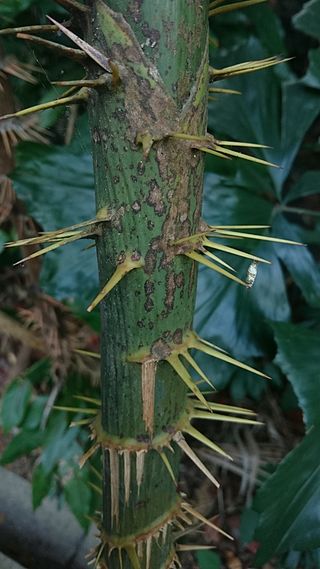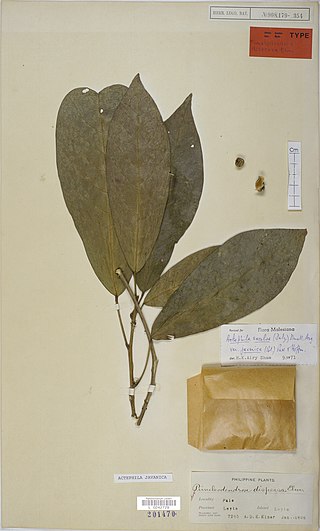
Rattan, also spelled ratan, is the name for roughly 600 species of Old World climbing palms belonging to subfamily Calamoideae. The greatest diversity of rattan palm species and genera are in the closed-canopy old-growth tropical forests of Southeast Asia, though they can also be found in other parts of tropical Asia and Africa. Most rattan palms are ecologically considered lianas due to their climbing habits, unlike other palm species. A few species also have tree-like or shrub-like habits.

The Nicobar Islands rain forests is a tropical moist broadleaf forest ecoregion in the Nicobar Islands. The Nicobar Islands are in the Indian Ocean, lying north of Sumatra and south of the Andaman Islands. The islands are politically part of India, although physically closer to Southeast Asia. Millions of years of isolation from the mainland has given rise to a distinct flora and fauna, including many endemic species.
Middle Button Island National Park is an Indian national park located in the Andaman and Nicobar Islands. The park was created in 1979 and is situated about 200 km (124 mi) northeast of Port Blair, capital of the island group. The total area that the national park covers is about 64 km2 (25 sq mi). Along with the neighbouring islands of North Button and South Button, both also national parks, it forms part of the Rani Jhansi Marine National Park off the coast of South Andaman Island.
South Button Island National Park is a national park located in the Andaman and Nicobar Islands off the coast of India, the total area of this protected island is about 5 km2 (2 sq mi), which make it as the smallest national park in India. Along with the neighbouring islands of North Button and Middle Button, both also national parks, it forms part of the Rani Jhansi Marine National Park off the coast of South Andaman Island.

Daemonorops was a genus of rattan palms in the family Arecaceae. Its species are now included within the genus Calamus.

Korthalsia is a clustering genus of flowering plant in the palm family spread throughout Southeast Asia. It is a highly specialized rattan with some species known to have an intimate relationship with ants, hence the common name ant rattan. High-climbing and armed with spines, the genus is named for the Dutch botanist P. W. Korthals who first collected them from Indonesia.

Myrialepis is a monotypic genus of flowering plant in the palm family. The single species, Myrialepis paradoxa, is native to Southeast Asia. The genus name is a combination of the Greek words meaning "innumerable" and "scale", a description of the fruit, and the epithet is Latin for "paradox".

Calamus rotang, also known as common rattan, is a plant species native to India, Sri Lanka and Myanmar (Burma). It is one of the scandent (climbing) rattan palms used to make Malacca cane furniture, baskets, walking-sticks, umbrellas, tables and general wickerwork, and is found in Southwest Asia. The basal section of the plant grows vertically for 10 metres or so, after which the slender, tough stem of a few centimetres in diameter, grows horizontally for 200 metres or more. It is extremely flexible and uniform in thickness, and frequently has sheaths and petioles armed with backward-facing spines which enable it to scramble over other plants. It has pinnate, alternate leaves, 60–80 cm long, armed with two rows of spines on the upper face.

Calamoideae is a subfamily of flowering plant in the palm family found throughout Central America, South America, Africa, India, China, Southeast Asia and Australia. It is represented by 21 genera - containing nearly a quarter of all species in the palm family - including the largest genus, Calamus, the type genus of the group. Only four are found in the New World while the rest are Old World denizens, usually found in equatorial swampland or along tropical coastlines.

Actephila excelsa is a species of shrub in the family Phyllanthaceae. It is native to an area in Tropical Asia and Zhōngguó/China, from Sulawesi to India and Guangxi. It is a highly variable species and leaf forms vary across adjacent ecozones. The plant is used in building houses and as a vegetable. Grey-shanked douc langurs eat the leaves.
Plectocomia pierreana is a species of liana in the Arecaceae, or palm tree, family. It is a spiny climber, with either a single stem or a cluster of stems up to 35 m in length, stems are 1 to 9 cm in diameter. Its spines are up to 2 cm long.
A large, very high liana, or "climbing tree" in the palm family, Korthalsia laciniosa occurs in the closed forests of Java, Sumatra, the Philippines, Malay Peninsula, Vietnam, Cambodia and elsewhere in Indochina, and the Nicobar and Andaman Islands.
Calamus tetradactylus is a climbing plant in the Arecaceae, or palm, family, and is part of a subfamily, Calamoideae, whose members are usually called rattans in English. It is native to southeast and east Thailand, Cambodia, Vietnam, south and central Laos, and Yunnan and elsewhere in southeast China. It grows in evergreen forest and scrub between 100 and 1,000m elevation. In Cambodia, it is described as a large and long rattan, its stalk growing from 20 to 70m long, growing in secondary formations near rivers.
Native to south Vietnam and Cambodia, Calamus salicifolius, is commonly referred to as a rattan, it is one of many Calamus species of the Arecaceae, or palm, family. It is described as a little bushy plant, often climbing, even on itself, with a 2 to 4m long stalk. It is found in deforested/severely degraded lowland areas and near houses, growing well in grasslands, scrub, roadside verges, ricefield bunds and peri-urban wastelands. Typically it occurs in floodplains with seasonal shallow flooding.
Calamus latifolius is a climbing plant, part of a subfamily, Calamoideae, whose members are usually called rattans in English, they are part of the Arecaceae, or palm, family.
Part of a group, the subfamily Calamoideae, whose members are usually called rattans in English, Calamus godefroyi, is a climbing plant, and part of the Arecaceae, or palm, family.
Calamus bousigonii, is a liana, a climbing plant, and part of the Arecaceae, or palm, family. It is a member of the subfamily Calamoideae, whose members are usually called rattans in English,
Calamus poilanei is an Asian species of tropical forest rattan liana in the family Arecaceae. Its native range is Thailand, Laos, central and southern Vietnam and no subspecies are listed. Its name in Vietnamese is (mây) song bột, wai nampung in Thailand and wai khom or wai thoon in Laos.
Calamus erectus, also known as viagra palm and locally as tynriew, tara, and zhi li sheng teng, is a flowering shrub in the family Arecaceae. The specific epithet (erectus) refers to the plant's habit of growing straight rather than creeping or climbing like many species of the genus Calamus.

Calamus draco is an Asian species of rattan plant in the family Arecaceae; its native range is from peninsular Thailand to western Malesia. It is a source of the red resin known as dragon's blood, which is a pigment with medicinal uses.








